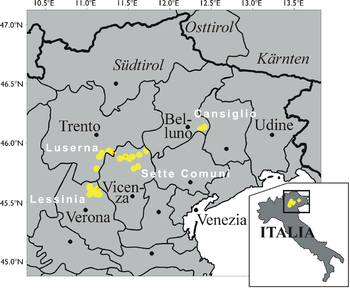Cimbrian language
| Cimbrian | |
|---|---|
| Zimbrisch | |
| Native to | Italy |
Native speakers | 400 (2000[1])[2] |
| Language codes | |
| ISO 639-3 |
cim |
| Glottolog |
cimb1238[3] |

Cimbrian (German: Zimbrisch or Tzimbrisch; Italian: Cimbro) refers to any of several local Upper German varieties spoken in northeastern Italy. The speakers of the language are known as Zimbern.
Cimbrian is a Germanic language related to Bavarian and most probably deriving from a Southern Bavarian dialect (although a Lombardic origin cannot be ruled out). It is also related to the Mócheno language. Its many essential differences in grammar as well as in vocabulary and pronunciation make it practically unintelligible for people speaking Standard German or Bavarian. Bavarian is also spoken in the province of South Tyrol. The impact of the surrounding varieties of Italian on Cimbrian has been very strong.
History
The earliest record of the movement of Bavarians to Verona dates to ca. 1050 (Bayerische Staatsbibliothek Cod. lat. 4547). The settlement continued during the 11th and 12th centuries.
A theory of Lombardic origin of the Zimbern was proposed in 1948 by Bruno Schweizer and again in 1974 by Alfonso Bellotto.[4] The debate was again revived in 2004 by Cimbrian linguist Ermenegildo Bidese.[5] The majority of linguists remains committed to the hypothesis of medieval (11th to 12th century) immigration.[6]
The presence of Germanic-speaking communities in Italy was discovered by the Italian humanists in the 14th century, who associated them with the Cimbri who arrived in the region in the 2nd century BC, whence the current endonym (Zimbar) has probably been adopted. An alternative hypothesis derives the name from a term for "carpenter", cognate with English timber.
Dialects
The three major dialects of Cimbrian are spoken in:
- the Seven Communities (Siben Komoin), currently only the village of Roana (Robàan)
- Luserna (Lusern), in Trentino
- the Thirteen Communities (Dreizehn Komoin), currently only the village of Giazza (Ljetzan)
- some villages in the Carnic Alps as Sappada, Sauris and Timau
Cimbrian is in danger of extinction both from standard Italian, which is often used in public, and the neighboring regional Venetian language. It is estimated that about 2,220 people speak Cimbrian.
In Trentino, according to the census of 2001, the first in which data on native languages were recorded, Cimbrian was spoken by a majority in the municipality of Lusérn (267 people, 89.9%). In other municipalities of Trentino 615 persons declared themselves members of the Cimbrian linguistic group, a total of 882 in Trentino.[7]
Status
Cimbrian is officially recognised in Trentino by provincial and national law. Starting in the 1990s, various laws and regulations have been passed by the Italian parliament and provincial assembly that put the Cimbrian language and culture under protection. A cultural institute was founded by decree, whose purpose is to safeguard and educate on the language. School curricula were adapted in order to teach in Cimbrian, and street signs are being changed to be bilingual.
Example
| Cimbrian | German | English |
|---|---|---|
|
Christus ist au gestanden |
Christ ist auferstanden |
Christ is risen |
References
- ↑ http://www.unesco.org/languages-atlas/index.php?hl=en&page=atlasmap&lid=352
- ↑ Cimbrian at Ethnologue (18th ed., 2015)
- ↑ Nordhoff, Sebastian; Hammarström, Harald; Forkel, Robert; Haspelmath, Martin, eds. (2013). "Cimbrian". Glottolog. Leipzig: Max Planck Institute for Evolutionary Anthropology.
- ↑ Bruno Schweizer: Die Herkunft der Zimbern. In: Die Nachbarn. Jahrbuch für vergleichende Volkskunde 1, 1948, ISSN 0547-096X, S. 111–129.; Alfonso Bellotto: Il cimbro e la tradizione longobarda nel vicentino I. In: Vita di Giazza e di Roana 17-18, (1974) S. 7–19; Il cimbro e la tradizione longobarda nel vicentino II. In: Vita di Giazza e di Roana 19-20, (1974) S. 49–59.
- ↑ Ermenegildo Bidese Die Zimbern und ihre Sprache: Geographische, historische und sprachwissenschaftlich relevante Aspekte. In: Thomas Stolz (ed.): Kolloquium über Alte Sprachen und Sprachstufen. Beiträge zum Bremer Kolloquium über „Alte Sprachen und Sprachstufen“. (= Diversitas Linguarum, Volume 8). Verlag Brockmeyer, Bochum 2004, ISBN 3-8196-0664-5, S. 3–42.Webseite von Ermenegildo Bidese
- ↑ James R. Dow: Bruno Schweizer's commitment to the Langobardian thesis. In: Thomas Stolz (Hrsg): Kolloquium über Alte Sprachen und Sprachstufen. Beiträge zum Bremer Kolloquium über „Alte Sprachen und Sprachstufen“. (= Diversitas Linguarum, Volume 8). Verlag Brockmeyer, Bochum 2004, ISBN 3-8196-0664-5, S. 43–54.
- ↑ "Tav. I.5 - Appartenenza alla popolazione di lingua ladina, mochena e cimbra, per comune di area di residenza (Censimento 2001)" (PDF). Annuario Statistico 2006 (in Italian). Autonomous Province of Trento. 2007. Retrieved 2011-05-12.
Further reading
- Baum, Wilhelm (1983). Geschichte der Zimbern. Storia dei Cimbri (in German). Landshut: Curatorium Cimbricum Bavarense.
- Schmeller, J. A. (1855). Cimbrisches Wörterbuch (in German). Vienna: K. K. Hof- und Staatsdruckerei.
- Kranzmayer, Eberhard (1981, 1985). Laut- und Flexionslehre der deutschen zimbrischen Mundart (in German). Vienna: VWGÖ. ISBN 3-85369-465-9. Check date values in:
|date=(help) - U. Martello-Martalar: Dizionario della Lingua cimbra. Vicenza 1974. Bd 2. Dal Pozzo, Roana-Vicenza 1985. (in Italian)
- Ermenegildo Bidese (ed.): Das Zimbrische zwischen Germanisch und Romanisch. Brockmeyer, Bochum 2005. ISBN 3-8196-0670-X
- Tyroller, Hans: Grammatische Beschreibung des Zimbrischen von Lusern (Franz Steiner Verlag, Stuttgart, 2003). ISBN 3-515-08038-4
- Bruno Schweizer: Zimbrische Gesamtgrammatik. Vergleichende Darstellung der zimbrischen Dialekte (= Zeitschrift für Dialektologie und Linguistik, Beiheft 132). ed. James R. Dow, Franz Steiner Verlag, Stuttgart 2008, ISBN 978-3-515-09053-7.
External links
| German Wikisource has original text related to this article: |
| Cimbrian language test of Wikipedia at Wikimedia Incubator |
![]() Media related to Cimbrian language at Wikimedia Commons
Media related to Cimbrian language at Wikimedia Commons
| ||||||||||||||||||||||||||||||||||||||||